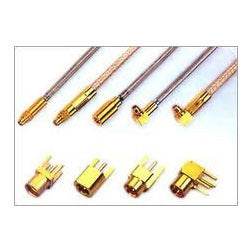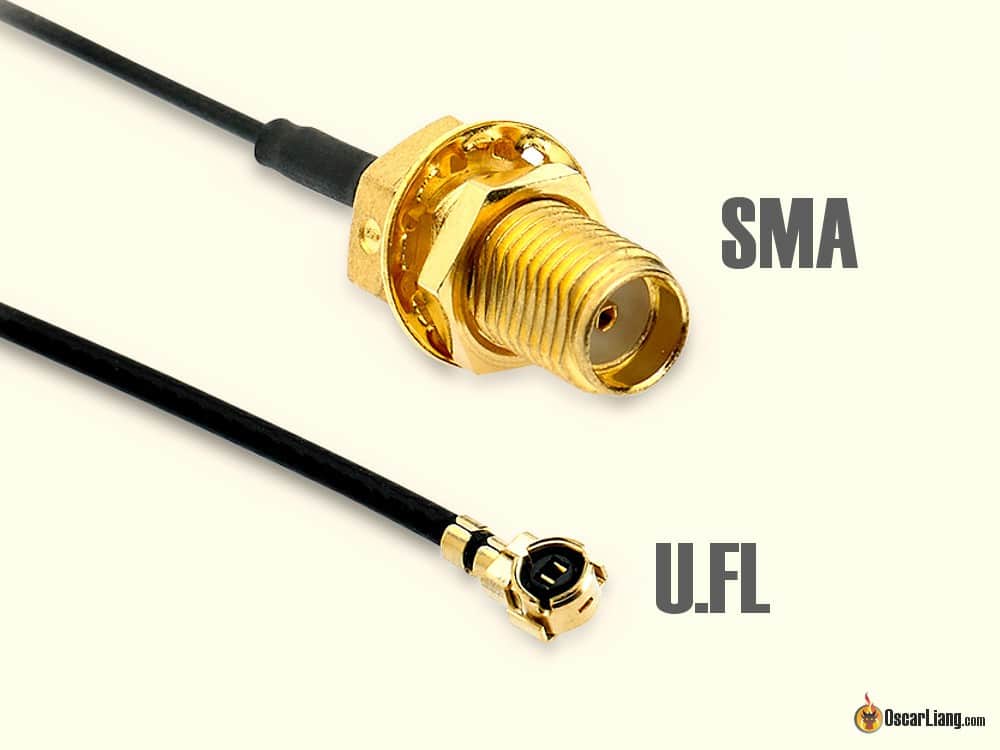SMA stands for Sub-Miniature Version A. These are coaxial RF connectors developed in the 1960s.
RP-SMA stands for Reverse Polarity SMA). It is a variation of the SMA connector which reverses the gender of the interface.
There is no difference with video/signal quality between these connectors, but you’ll read further down why we even have these 2 different types. Generally speaking, SMA appears to be more popular choice of connector especially in the mini quad (racing drone) industry.
Here is a comparison table of the SMA antenna and RP-SMA antenna connectors.
For most of us, it would take some time to get to know which was which off the top of our heads. For those who are still getting used to remembering them, an SMA antenna basically has the pin in the middle while the RP-SMA antenna is the exact opposite with a small hole in the centre. It’s not that hard so I’m not coming up with a nursery rhyme to remember it like some others do. :-)
SMA to RP-SMA Adapter – Angle Connector
If you happened to have antennas of the wrong connector, you can get an adapter for it. Some even come with angle to make antenna mounting more flexible.
However note that there is some performance loss to every adapter you use. So avoid it whenever possible.
- Straight SMA to RP-SMA / RP-SMA to SMA Adapter
- 45 degree angle adapter
- 90 degree SMA to SMA Adapter
- 90 degree RP-SMA to RP-SMA adapter
Removing/Changing SMA Connectors
Many will often replace the connector with the ones they prefer or may choose to add a “pigtail”extension” on the video transmitter to save the components from breaking off.
Whether you are just adding a pigtail or directly soldering the antenna to the VTX, the same steps apply to both. This is a very useful trick and quite easy to do with a bit of soldering skill.
For replacing RP-SMA to SMA or vice versa (on video transmitter), simply cut off the bulk of the connector with some wire cutters or dremel cutting wheel, and use your iron to remove the remaining little legs off the VTX surface. If you’re really handy with an iron or have a heat gun, you can remove it without needing to cut anything off.
An important thing to keep in mind is that an antenna coaxial cable is made up of a ground shielding and signal wire. The ground shielding is the conductive outer layer of the antenna and is used as a shield to help keep interference and RF voodoo magic in line. The signal line runs inside along the middle separated from the ground shielding by a silicone or plastic layer. Do not just solder one end to the other, ground must connect to ground and signal to signal.
When doing the pigtail mod
- Cut off the end you don’t need and strip back approximately 3-5mm of the outer coating exposing the first ground shield layer
- Pull the few mm of ground wires back to expose the middle section of the cable
- Strip just the tip of the signal coating about 1mm to expose just the tip of the signal wire
- Tin both the ground and signal separately, you can split the ground into 2/3/4 separate strands depending on how many ground pads there are to solder to.
- Be sure there is enough length so the grounds won’t touch the signal wire; Be sure to note which pins/pads are the grounds and the signal
- Solder the signal first to the corresponding pad (usually the centre pad) and then start soldering on the surrounding grounds.
- Last step is to find a suitable place for the connector, most usually mount it to the frame away from the receiver antenna on the quad. Voila, a crash proof VTX connector!
VTX’s that come with pigtail
If you’re not so handy with the soldering iron or don’t even want to consider such a task, there are many vendors out there now that sell VTX’s with pigtails already installed or have a variety of mounting and connector options to suit your builds.
UFL Connectors
AKA IPEX connectors, U.FL has been a popular connector choice in many small size video equipment and antennas. They have actually been the most popular type of connector on radio receivers too due to their compact sizes.
However, they are a lot more fragile than standard SMA/RPSMA connectors and they have a very limited mating cycle.
But in the never-ending search for shaving weight, this may be a great choice. Current options with this type of connector including the TBS Unify Pro HV and the Immersion Tramp HV.
MMCX Connectors
MMCX connectors are slightly smaller and lighter than SMA connectors, but much tougher than U.FL. More and more VTX and antennas are picking up this connector and we can only expect it to play a bigger role in FPV.
FPV Drone Battery Connectors
There are a whole series of available LiPO battery connectors. The most common connector is the yellow XT60 which is used on about 95% of 220mm sized quadcopters running a 3S-6S LiPO FPV Drone Battery. Micro drones such as the Tiny Whoop commonly use the JST-XH as it provides more current flow from the battery compared to the smaller JST-PH. The following table summarizes the most commonly used battery connectors:

LiPO batteries (except in the case of a 1S) will also have a balance lead. This is a standard JST-XH connector with 3-7 pins that is used to balance charge the battery pack. More information on balance charging can be found here [insert hyperlink to charging/balance charging article]. This connector has one positive pin for every cell in the battery pack and a ground wire (usually black). A battery checker can be plugged into this connector to monitor the voltage of each individual LiPO cell, simplifying the process of distinguishing charged and discharged batteries.
Balance Connectors
JST-XH Balance Connector

Main Power Connectors
There are several variations of main connectors available. Deciding on which one is right for you is a case of a combination of the application (subsequent current demands), size of the model and restrictions the physical pack and wiring may provide.
JST Battery Connector

This is a small power connector and is commonly found on small models, toys and small lipo packs. JST connectors carry low currents (5 amps) and are most commonly found in on-board electrics such as servos, gyros, receivers and receiver switches.
Deans Battery Connector
These are very popular connectors and seem to be the most commonly used. They are rated at 50 amps continuous load. When soldering, they require
EC3 Battery Connector

EC3's are becoming very popular as they use true "bullet style" connection pins and are rated for up to 60 amps of continuous load. Most will agree bullet pins make for the best possible connection when dealing with high current applications, due to a larger surface contact area.
EC5 Battery Connector

These are a longer version of the EC3 and because the bullet pins are longer (5mm) they have an greater surface area for contact. EC5's are rated for up to 120 amps of continuous load. These are perfect for large 1/4 scale electrics and 700 size electric helis. They are the more expensive connectors in the market, but offer a good solution for very high current situations.
XT-60 Battery Connector
XT-60 connectors are becoming more and more popular due to competitive pricing and overall performance. XT60 are one of the easier connectors to solder, providing opposing solder terminals with lots of space to work with. However, they still require heatshrink to insulate the negative and positive terminals.
Tamiya Connectors
These are lower amp connectors and were once very popular, especially with the electric RC car, truck, and boats. However, since higher amp Lipo’s have entered the scene, Tamiya plugs are used less and less. You will still find them on entry level RC hobby products, but they are not really designed to take large currents and tend to get very hot, and in some extreme cases, melt together.
Traxxas Connectors
Uused exclusively on electric Traxxas RC vehicles/boats but can fit to any high current application up to about 100 amps. Traxxas connectors look great, but they have a fundamental design flaw when it comes to soldering. They use small gold pins that the wire is soldered to. The small pin is then inserted into the plastic connector, but soldering the pins is very tricky, it needs to be very neat and within 3-4mm of the bottom of the pin.
Anderson “Sermos” Power Poles
The connectors can be joined together to make a positive and negative all in one connection or left apart for connecting batteries in series. Anderson Sermos connectors are also the only non gender connector available. This means that not only can they be connected in series, but each connector can be male or female.
HXT 4mmm Connector
These connectors are commonly found on our high C and mah rated Lipo batteries. These are rated at 93amps, with a large plastic connector that can handle very thick gauge wire.


















